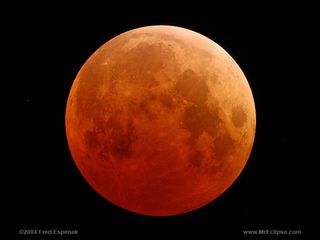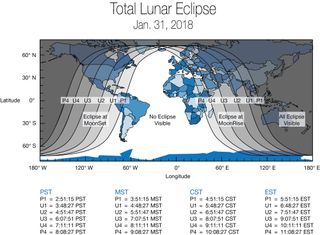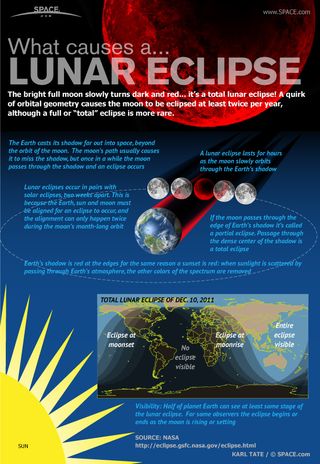Get Ready for the 'Super Blue Blood Moon' Eclipse of Jan. 31!
Almost two and a half years have passed since the moon last plunged completely into the Earth's shadow. But if you live in Hawaii, Alaska or the western half of North America, be sure to put a big circle on your calendar for Wednesday, Jan. 31.
Early that morning, you will have an opportunity to see the second full moon of January — popularly known as a "Blue Moon" — become totally eclipsed. NASA has even dubbed the event a "Super Blue Blood Moon," as it will occur near when the moon is at its closest point to Earth, a so-called "supermoon." [Super Blue Blood Moon 2018: When, Where and How to See It]
Interestingly, this will be the first time in over 150 years (since March 31, 1866, to be exact) that a total lunar eclipse will coincide with a Blue Moon in North America.
But a controversy has recently emerged regarding this dating.
Calendrical commotion

In a recent report by Time.com, Ernest Wright, a programmer in the Scientific Visualization Studio at NASA's Goddard Space Flight Center, and Fred Espenak, a famed eclipse expert and retired NASA astrophysicist, were quoted as saying that the last total lunar eclipse during a Blue Moon was on Dec. 30, 1982.
However, Wright and Espenak were using Universal Time (UT) for dating the December 1982 full moons. While December of 1982 was a double full-moon month for Europe and the Eastern Hemisphere, and the full moon of Dec. 30 was indeed a blue moon, that first full moon on Dec. 1, 1982, actually occurred on the previous day(Nov. 30) as seen from North American time zones.
Only for a few areas was the December 1982 total eclipse both visible and coincident with a Blue Moon: a section of eastern Asia (including Japan and Korea), Australia, New Zealand, and the Pacific Ocean west of the International Date Line. But for North Americans, there was only one full moon in December 1982, so the full moon that was totally eclipsed that month was not a blue moon.
Get the Space.com Newsletter
Breaking space news, the latest updates on rocket launches, skywatching events and more!
Thus, while people in the Eastern Hemisphere saw their last Blue Moon total lunar eclipse in 1982, for the Western Hemisphere, this upcoming eclipse will indeed be the first Blue Moon total eclipse since 1866.
If you're wondering when the next Blue Moon total eclipse will occur … guess what? More confusion. As Wright asks, "Just out of curiosity, how would you characterize the total lunar eclipse of Jan. 1, 2048? It's visible in the entire lower 48 [states], but going by time zones, this is a Blue Moon for the western half of the U.S. (where it will occur on Dec. 31, 2047) but not the eastern half (where it occurs at the very beginning of the following year)!"
Eclipse timetable of events

Unlike an eclipse of the sun, which often requires viewers to make a long journey to the path of totality, eclipses of the moon can be observed from one's own backyard. The passage of the moon through the Earth's shadow is equally visible from all places within the hemisphere where the moon is above the local horizon.
For many of us, a total eclipse of the moon can be enjoyed purely as a spectacle, a chance to appreciate nature in an unfamiliar guise. But many kinds of careful observations of a lunar eclipse can hold scientific interest. For example, we can try to get a good indication of the size of Earth's shadow by timing when it first appears to encroach upon the disk of the moon and when the last vestige of the shadow moves off the moon's disk (referred to as "contact timings").
Another method is to time when selected craters are swept by the advancing shadow. Using a standard list of lunar craters, one can carefully measure the exact time when each crater enters and leaves the umbral shadow. Such crater timings can be used to estimate the enlargement of Earth's atmosphere due to airborn dust and volcanic ash.
Even with the unaided eye, a lunar eclipse is pleasing to watch, but binoculars will certainly improve the view, though a small telescope is recommended. You should use your lowest-power eyepiece.
The beginning of a lunar eclipse happens simultaneously for every viewer, and the end will happen simultaneously for everyone, too. This is unlike an eclipse of the sun. Hence, the simple schedule below holds for all places (the times differ only because of time zones). The moon's passage through the Earth's shadow is presented for six time zones: one for Hawaii (HST), one for Alaska (AKST), and four across the U.S and Canada: Pacific (PST), Mountain (MST), Central (CST) and Eastern (EST). Dashes indicate that the moon has set and is no longer visible.
| Partial eclipse begins | 1:48 a.m. | 2:48 a.m. | 3:48 a.m. | 4:48 a.m. | 5:48 a.m. | 6:48 a.m |
| Total eclipse begins | 2:51 a.m. | 3:51 a.m. | 4:51 a.m. | 5:51 a.m. | 6:51 a.m. | ---- |
| Mid-eclipse | 3:29 a.m. | 4:29 a.m. | 5:29 a.m. | 6:29 a.m. | ---- | ---- |
| Total eclipse ends | 4:07 a.m. | 5:07 a.m. | 6:07 a.m. | 7:07 a.m. | ---- | ---- |
| Partial eclipse ends | 5:11 a.m. | 6:11 a.m. | 7:11 a.m. | ---- | ---- | ---- |
Alaska and Hawaii are in the best position for viewing this event; the eclipse will happen during the predawn hours of Jan. 31, with the moon high in the sky. From Northern California, the northwest corner of Nevada, all of Oregon and Washington, the Idaho panhandle, as well as the Canadian provinces of British Columbia and most of Alberta, the moon will set after it completely exits the Earth's dark umbral shadow (6:08 a.m. PST, 7:08 a.m. MST). For the rest of North America, the eclipse will still be in progress when the moon sets.
Unfortunately, for those living in the Canadian Maritime provinces (New Brunswick, Prince Edward Island, Nova Scotia, Newfoundland and Labrador), the first sign of the eclipse — the appearance of the moon's much fainter penumbral shadow — will just start becoming evident by the time the moon sets. As a consolation, however, there will be less than a year to wait for another North American total lunar eclipse that will be fully visible from start to finish for these locations.
The total phase
This week, we will concentrate solely on viewing the moon during the total phase of the eclipse. During the 76 minutes that the moon is completely immersed in the Earth's dark umbral shadow, the big question will be how the natural satellite will appear in the sky. Some eclipses are such a dark, blackish gray that the moon nearly vanishes from view. In other eclipses, the moon may seem to glow like a bright orange ember.
The reason that the moon can be seen at all during totality is that sunlight is scattered and refracted around the edge of the Earth by our atmosphere. If an astronaut were standing on the moon's surface during totality, the sun would be hidden behind a dark Earth. The planet would appear roughly four times larger than the sun and would be rimmed by a brilliant, reddish ring of all the world's sunrises and sunsets.
How bright this ring around the Earth appears depends on global weather conditions and the amount of dust suspended in the air. A clear atmosphere on Earth means the moon will appear bright during the lunar eclipse. But if a major volcanic eruption has recently injected particles into the stratosphere, the moon will likely appear very dark.
On the Indonesian island of Bali in November, a volcano called Mount Agung spewed ash 5.5 miles (8.8 kilometers) into the sky. This could help make the upcoming eclipse a relatively dark one. A major eruption of this same volcano in 1963 caused the moon to almost completely vanish in an eclipse that December.
During the upcoming eclipse, the moon will track through the southern part of the Earth's shadow. The moon's orientation as seen from the western U.S. and western Canada means that the satellite's left portion should appear brightest; that will be the part of the moon nearest to the shadow's edge. There may be a gradation in hue between the parts of the disk nearest and farthest from the shadow's center.
A careful description of the colors seen on the eclipsed moon and their changes is valuable. The hues depend on the optical equipment used, usually appearing more vivid when viewed with the naked eye than with telescopes. The French astronomer André-Louis Danjon introduced the following 5-point scale of lunar luminosity ("L") to classify eclipses:
L = 0: Very dark eclipse, moon almost invisible, especially in midtotality
L = 1: Dark eclipse, gray or brownish coloration, details distinguishable only with difficulty
L = 2: Deep red or rust-colored eclipse, with a very dark central part in the shadow, and outer edge of the umbra relatively bright
L = 3: Brick-red eclipse, usually with a bright or yellow rim to the shadow
L = 4: Very bright copper-red or orange eclipse, with a bluish very bright shadow rim
Examine the moon at midtotality and near the beginning and end of totality to get an impression of both the inner and outer umbra. In noting an L observation, state the time and optical means used.
At midtotality, in locations where morning twilight has not yet begun, the darkness of the sky is impressive. Faint stars appear, and the surrounding landscape takes on a somber hue. As totality ends, the eastern edge of the moon emerges from the umbra, and the sequence of events repeats in reverse order until the spectacle is over.
Another procedure you can try while observing the lunar eclipse is to estimate the stellar magnitude or brightness of the moon during totality. When it's faintest, at midtotality, the moon may be similar in brightness to naked-eye planets or prominent stars. To see the moon and stars as comparable disks, some nearsighted observers need only remove their glasses. Another technique is to view the eclipsed moon and the comparison stars simultaneously through binoculars held backward, so that the large objective lenses are nearest the eyes.

What colors? How bright? Tell us!
I would like to invite all Space.com readers to email me at skywayinc@aol.com with their observations concerning the color and brightness of the eclipse. Send me your L-estimate (be sure to give your location, note the time you made your observation and tell me what instrument, if any, you used). Also, try to estimate of the brightness of the moon compared with bright stars and planets.
Next week, we'll go into greater detail on the special circumstances of viewing a lunar eclipse at moonset.
Editor's note: If you capture an amazing photo of video of the Jan. 31 total lunar eclipse and would like to share it with Space.com for a story or gallery, send images and comments to: spacephotos@space.com.
Joe Rao serves as an instructor and guest lecturer at New York's Hayden Planetarium. He writes about astronomy for Natural History magazine, the Farmers' Almanac and other publications, and he is also an on-camera meteorologist for Verizon Fios1 News, based in Rye Brook, N.Y. Follow us @Spacedotcom, Facebook or Google+. Originally published on Space.com.
Join our Space Forums to keep talking space on the latest missions, night sky and more! And if you have a news tip, correction or comment, let us know at: community@space.com.

Joe Rao is Space.com's skywatching columnist, as well as a veteran meteorologist and eclipse chaser who also serves as an instructor and guest lecturer at New York's Hayden Planetarium. He writes about astronomy for Natural History magazine, the Farmers' Almanac and other publications. Joe is an 8-time Emmy-nominated meteorologist who served the Putnam Valley region of New York for over 21 years. You can find him on Twitter and YouTube tracking lunar and solar eclipses, meteor showers and more. To find out Joe's latest project, visit him on Twitter.
